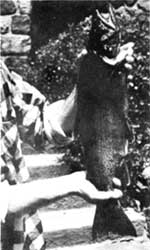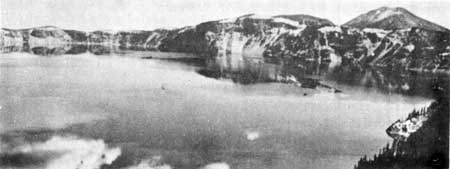|
Volume XXI - 1955
Fishing At Crater Lake National Park
By Joseph C. Hunt, Seasonal Ranger
Photos by C. Warren Fairbanks
PART I - STREAMS
Many park visitors are interested in the fishing conditions here in
Crater Lake National Park. In most cases, fishing is limited. For
example, the streams are very hard to reach. Annie Creek and Castle
Creek are cut into steep canyons with sheer walls. Brush is also a
handicap to the fisherman. Sand Creek at the East Entrance, where the
pinnacles are located, is a prime example of stream conditions; this
stream can be seen from the highway.
Small rainbow trout, Salmo gairdneri irideus Gibbons, and
eastern brook trout, Salvelinus fontinalis (Mitchill) are
abundant in the streams. The size of the trout caught in these streams
averages about eight inches. One of the reasons for the smallness of the
trout is that the snow pack is very deep in these canyons, reducing the
food supply by covering the streams. From late in July until September,
these streams are usually free from snow.
Bait fishing is a good standby that brings fine results. Fly fishing
is almost useless because of the brush cover in the area. Spin fishing
is difficult, the streams being too small.
If the hardy fisherman can overcome these handicaps, however, he
should be able to catch his limit of ten fish in these beautiful
mountain brooks.
PART II - THE LAKE
Crater Lake, in addition to being one of the most beautiful lakes in
the world and, according to some, one of the seven natural wonders of
the earth, is also one of the most interesting as far as angling is
concerned.
There are two main types of fish in the lake. The first is the
landlocked red, sockeye, or kokanee salmon, Oncorhynchus nerka
kennerlyi (Suckley), which I do not consider to be a good type of
fish for this lake. They do not grow very large, and, as far as angling
is concerned, I can not consider them game fish. These fish range
between nine and thirteen inches in length. Very seldom is a fish caught
that is larger or smaller. They are small in body structure and weigh
little for their size.

Sockeye salmon from Crater Lake
|
The rainbow trout, Salmo gairdneri irideus Gibbons, in Crater
Lake, however, is a much different fish in comparison with the salmon.
This fish grows large and is a vicious fighter. Like most lakes that
fishermen enjoy, Crater Lake could be one of their favorites if they
understood the habits of the rainbow trout in this lake. The park
visitor who fishes in the lake is usually not familiar with the habits
of these trout. Therefore, many draw a wrong conclusion about the great
fishing that Crater Lake offers.
The length of the rainbow ranges between fifteen and one-half and
twenty-three inches, the average measuring nineteen inches and weighing
about three pounds. These fish are deep feeders, the reason being that
the summer is so short that surface feeding for bugs is limited. Some
say the water is so clear that, in order to escape the rays of the sun,
they have to seek shelter in deep water or under overhanging rocks.
Trolling at around seventy feet deep produces fine results; however,
it is not great sport because of the weight of the spoons and sinkers.
Spin fishing is the sport in the lake. With a light spinning rod and a
light-test line, using a quarter-ounce lure, a fisherman will have a
wonderful time on the lake; but along with all this, he will have many
heartaches.

23-3/4-inch rainbow trout taken from Crater Lake
in August, 1954
|
The mouths of the trout are very soft. Once hooked, these fish break
water and in two or three jumps are usually free. The fisherman can
expect to land one of every five that he hooks. There have been many
stories which attempt to explain their tearing loose so easily. One
possible suggestion is that the lack of minerals in the water has a
weakening effect on the cartilage of their mouths. As a sidelight, let
me describe one of the strangest things about the rainbow trout in
Crater Lake. Once free, after breaking loose from the hook, they
continue to jump and break water, sometimes three feet into the air.
They may do this five or six times. An explanation for this might be
that their mouths are so soft that, having been torn by the hook, they
are actually in pain.
Very seldom does a fisherman catch a large rainbow on a flyrod using
artificial flies. Using a fly road limits one in the length of cast.
Also, the fish sees the movement through the clear water and will not
strike. Anglers have spent days on the lake without seeing a fish rise
for a live bug or fly. This seems strange for a lake that has been
stocked many years with rainbow trout.
Unless certain problems are solved in the future, good fishing in
the lake may cease. Crater Lake can not stand heavy fishing; the fish do
not reproduce in quantity. Contrary to popular opinion, I believe that
lack of food is not the handicap to reproduction in this lake. There are
many types of underwater life for the fish to feed on.
The grave problem is the absence of adequate spawning grounds. There
are no known inlets or outlets to Crater Lake, providing an unfavorable
situation for spawning trout. They must, therefore, find nesting grounds
in the lake. There are located around its edges a few sandy beaches that
otherwise would be ideal, but the wind creates such choppy water that
the roe would be washed away. The light pumicesand also shifts around in
the water. The spawner probably lays her eggs in the holes and cracks of
the steep walls around the shores of the lake. This is not an ideal
situation, because the eggs have little protection from other fish. When
the eggs have hatched, the fingerlings fall prey to their own
cannibalistic kind; apparently few escape this fate. If the fish that do
escape and reach maturity are caught by the angler, then the supply may
be exhausted.

Looking toward Mt. Scott from Sinnott Memorial
From Kodachrome by Welles & Welles
Views From Sinnott Memorial
By Willis G. Downing, Ranger Naturalist
If the name Sinnott Memorial is mentioned, most park visitors and
employees think at once of the excellent views of Crater Lake to be had
from that point and of the art and photograph exhibits in the room
behind the lookout platform. This, of course, is the reason for the
existence of this observation post. It is there to enable all who visit
Crater Lake to better appreciate its meaning -- scientific, scenic, and
aesthetic.
To the ranger naturalists who stand duty there, the lake and the
wall around it are of continual interest. The lake is never the same.
Even if it were, no single viewing of Crater Lake would impart complete
understanding to the viewer.
Some of the questions that visitors ask at Sinnott Memorial are
about the area just below and around this observation point. Many
interesting and sometimes unusual observations of mammal and bird life
have been made from Sinnott Memorial; for example, the viewing of
swimming eagles on different occasions by Dr. George C. Ruhle (Farner,
1952) and Ranger Naturalist John Mees (1954). I have enjoyed watching
some of the more usual antics and habits of the smaller mammals around
Sinnott Memorial. Any one of the smaller animals in that vicinity can be
an absorbing study in itself.
The golden-mantled ground squirrels are very much in evidence all
during the day. I have often marveled at their lack of appreciation of
the approximately 900-foot drop to the lake surface from Sinnott
Memorial. I have seen them scamper along the stone wall at the edge of
Sinnott Memorial and take a flying leap into midair. They invariably
land on some small crag of rock along the steep outer wall. Then they
will jump from one small outjutting to another until they reach the more
level ground west of Sinnott Memorial.
They leap, too, from rock to rock along the slide area east of this
observation post. Now and then one golden-mantled ground squirrel will
chase another away from some source of food. In the process of rapid
movement, he will dislodge a rock, and a rock slide begins. At the
beginning of the summer season, streams from melting snow caused larger
rocks to roll down this slope. When the snow disappears, minor erosion
continues as ground squirrels and an occasional marmot dislodge smaller
rocks from the slopes.
Like the ground squirrels, the marmots have no fear of the drop to
the lake surface. They do not jump from rock to rock as do the
squirrels, but scamper up the steep slide area east of Sinnott Memorial.
They seem startled when their movements start the rolling of a rock
downhill. Marmots are also agile in their movements on rocks. They often
climb and lie upon rocks a hundred feet or so below Sinnott
Memorial.
One of my rarer views of a marmot in action was obtained on the
grassy slope just west of the walk leading down to Sinnott Memorial.
Ranger Naturalist Edward Burnham first noticed a young marmot nibbling
at the head of a sedge. The marmots along the rim usually avoid
approaching humans. This one seemed an exception. He continued working
his way up the slope, standing, grabbing stalks of sedge in his two
front paws, and eating the seeds. Many visitors photographed this
unusual sight as the marmot approached within two or three feet of the
wall beside the walk.
To the interested observer, the slopes, slides, and rocks around
Sinnott Memorial can provide surprising discoveries about the habits and
ventures of golden-mantled ground squirrels, marmots, and other small
mammals that live thereabouts.
Literature Cited
Farner, Donald S. 1952. The Birds of Crater Lake National
Park. Lawrence, University of Kansas Press. xi, 187 pp.
Mees, John. 1954. Unusual eagle experiences. Nature Notes from
Crater Lake 20:5-6.
| 
